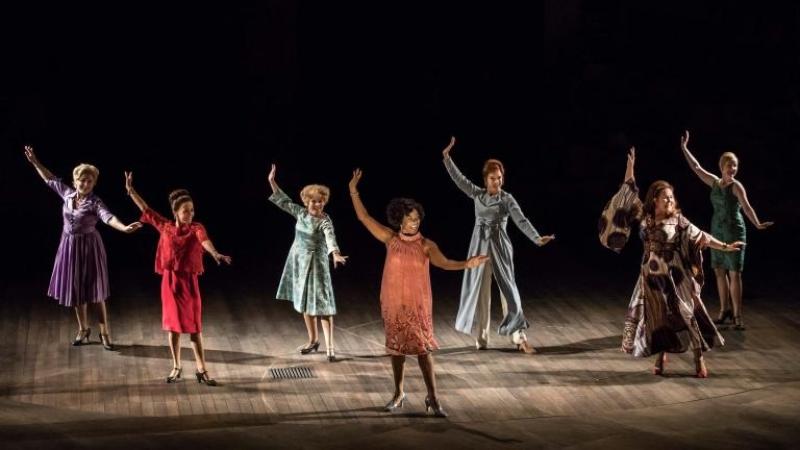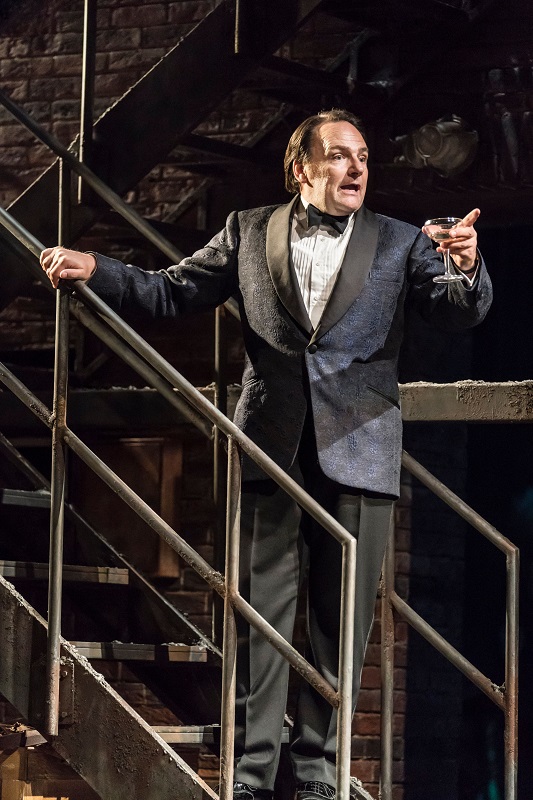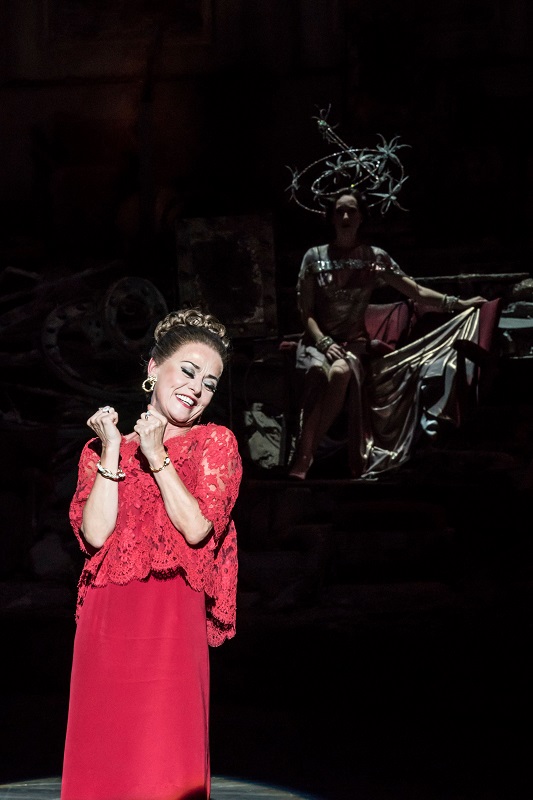Follies, National Theatre review - Imelda Staunton equal first in stunning company | reviews, news & interviews
Follies, National Theatre review - Imelda Staunton equal first in stunning company
Follies, National Theatre review - Imelda Staunton equal first in stunning company
Glitter and be sad as Sondheim's former showgirls gather for a momentous reunion

Of Sondheim’s half-dozen masterpieces, Follies is the one which sets the bar impossibly high, both for its four principals and in its typically unorthodox dramatic structure.
The introductory set-up will have a compelling strangeness for anyone new to Follies, and gets the lump in the throat going for those who know they're going to tear up rather often. Ghosts of the “beautiful girls” from the Weismann Follies, 1918 to 1941, haunt a dilipated, soon-to-be-demolished theatre, while their present (1971) selves arrive for a reunion to take up the sashes with the respective years printed on them. The score in those peerless arrangements by Jonathan Tunick, with additional work by Josh Clayton, quickly but unobtrusively works its haunting power both in the main events and in the underscoring (dance music for the reunion, including numbers cut from the original score like "Can That Boy Foxtrot" – think of what Bob Fosse did with the discards from the stage musical Cabaret). Music supervisor Nicholas Skilbeck and conductor Nigel Lilley have elicited the best possible work; there are stunning contributions from some of the best wind and brass in the business, jabbing away with the acid "wrong" notes or gracefully adding the bittersweet edge of Sondheim's beloved Ravel. Who’s going to be the standout – with whom will we most identify? It looks from her endearing first appearance as if it will be Imelda Staunton’s Sally Durant, now plain Mrs Plummer from Phoenix. Buddy Plummer (Peter Forbes) seems impossibly boisterous, Sally’s old flame Benjamin Stone (Philip Quast) too smooth, her old friend Phyllis Rogers (Janie Dee, pictured above with Staunton), now Mrs Stone, fashion-plate cool as an iceberg. But you never find terra firma in the Sondheim world, where cynicism and romantic love alike are not quite what they seem; James Goldman's book, too, is finer than I remembered. This quartet of peerless singer actors all win their laurels, and Staunton doesn’t steal the show other than when she’s supposed to – with the dreamy tenderness of “In Buddy’s Eyes”, spine-tingling evocation of the late Barbara Cook, and the torch-song twist on “The Man I Love”, “Losing My Mind”, which rises to lacerating anguish from a painful stillness.
Who’s going to be the standout – with whom will we most identify? It looks from her endearing first appearance as if it will be Imelda Staunton’s Sally Durant, now plain Mrs Plummer from Phoenix. Buddy Plummer (Peter Forbes) seems impossibly boisterous, Sally’s old flame Benjamin Stone (Philip Quast) too smooth, her old friend Phyllis Rogers (Janie Dee, pictured above with Staunton), now Mrs Stone, fashion-plate cool as an iceberg. But you never find terra firma in the Sondheim world, where cynicism and romantic love alike are not quite what they seem; James Goldman's book, too, is finer than I remembered. This quartet of peerless singer actors all win their laurels, and Staunton doesn’t steal the show other than when she’s supposed to – with the dreamy tenderness of “In Buddy’s Eyes”, spine-tingling evocation of the late Barbara Cook, and the torch-song twist on “The Man I Love”, “Losing My Mind”, which rises to lacerating anguish from a painful stillness.
 Dee, though, is equally powerful with the stillness, somehow held through much of the furious irony in “Could I Leave You?”, and she even saves one of the weakest numbers, “The Story of Lucy and Jessie” – “Ah, but Underneath!”, the original London replacement, is far better, though maybe less plot-related – with a Rita Hayworth transformation and sassy execution of Bill Deamer’s always spot-on choreography. Quast we knew as the perfect baritone of the musicals, and he doesn’t disappoint, but the great show voice of that wonderful actor Peter Forbes (pictured left) came as a revelation. He strips away the usual overkill of “Buddy’s Blues” and like the other three always keeps it real.
Dee, though, is equally powerful with the stillness, somehow held through much of the furious irony in “Could I Leave You?”, and she even saves one of the weakest numbers, “The Story of Lucy and Jessie” – “Ah, but Underneath!”, the original London replacement, is far better, though maybe less plot-related – with a Rita Hayworth transformation and sassy execution of Bill Deamer’s always spot-on choreography. Quast we knew as the perfect baritone of the musicals, and he doesn’t disappoint, but the great show voice of that wonderful actor Peter Forbes (pictured left) came as a revelation. He strips away the usual overkill of “Buddy’s Blues” and like the other three always keeps it real.
It takes all that to set aside, temporarily at least, our earlier wonderment at the blazing execution of torch songs from other Follies “girls”. The hits are indecently high, something more than the good tunes that pour out in, say, Oklahoma! Sondheim proves that the only worthwhile pastiche is that which loves what it's homaging. The towering showbiz of the evening comes from Tracie Bennett (pictured below with Emily Langham as Young Carlotta), the powerhouse who managed to give more than just a spot-on Judy Garland impersonation in End of the Rainbow. Fair enough, her character is the one who made it in films, so all eyes should be on her Carlotta – and they are. “I’m Still Here” has had so many great interpreters that it feels odd to call this the best I’ve seen, but so it felt. The Cole Porterish list unfolds, touchingly, to a group of listeners, Carlotta's contemporaries and the younger generation, who then melt away discreetly when it turns confessional - a typical sensitivity on Cooke’s part. So the final belt, triumph from adversity, is all the more worthy of the audience’s delirium.
 So, too, is the surprise of the voice that comes from Di Botcher’s very down-to-earth Hattie in “Broadway Baby”. Josephine Barstow, music-theatre diva, was never the sweet operetta soprano that made her Heidi Schiller the toast of Vienna – we hear it blossom in her younger self, Alison Langer – but she, too, commands attention whenever she’s on stage. And now I get the point of her "One More Kiss" in context - Lehar to the Mahlerian irony of Phyllis's waltz song, the next number.
So, too, is the surprise of the voice that comes from Di Botcher’s very down-to-earth Hattie in “Broadway Baby”. Josephine Barstow, music-theatre diva, was never the sweet operetta soprano that made her Heidi Schiller the toast of Vienna – we hear it blossom in her younger self, Alison Langer – but she, too, commands attention whenever she’s on stage. And now I get the point of her "One More Kiss" in context - Lehar to the Mahlerian irony of Phyllis's waltz song, the next number.
The big group number, “Who’s That Woman?”, should be foolproof. Sassily led by Dawn Hope’s Stella, it evokes the usual pleasure and goosebumps as young glamour-tappers join their older selves. An aged hoofer duo, Theodore (Billy Boyle) and Emily (Norma Atallah) Whitman enchant, and Cooke keeps the “ghosts” more often in play than even Sondheim might have envisaged. Youth has its day in the earlier versions of Phyllis, Sally, Ben and Buddy – the truthful standout in a fine quartet is Alex Young.
Maybe there’s still room for a radical reinvention of Follies – visionary director Richard Jones, of unforgettable Into the Woods status, has said it’s the one he’s most interested in - but you can only go so far with a drama fixed between 1918 and 1971, and in West End terms this delivers on every front. Never forget the enormous resources and expense that go in to one of the biggest company shows in the repertoire, with Vicki Mortimer’s designs, evocatively lit by Paule Constable, achieving a genuinely lovely transformation as gauzy wings drop down for “Loveland”, a vision in green wryly evocative of The Sleeping Beauty’s Act Three. And of course the Olivier's revolve does its stuff, but always pertinently. You leave giddy with the richness and complexity of it all. One of the great classics of the musical theatre is magnificently vindicated.
- Follies at the National until 3 January
- Read more theatre reviews on theartsdesk
Add comment
The future of Arts Journalism
You can stop theartsdesk.com closing!
We urgently need financing to survive. Our fundraising drive has thus far raised £49,000 but we need to reach £100,000 or we will be forced to close. Please contribute here: https://gofund.me/c3f6033d
And if you can forward this information to anyone who might assist, we’d be grateful.

Subscribe to theartsdesk.com
Thank you for continuing to read our work on theartsdesk.com. For unlimited access to every article in its entirety, including our archive of more than 15,000 pieces, we're asking for £5 per month or £40 per year. We feel it's a very good deal, and hope you do too.
To take a subscription now simply click here.
And if you're looking for that extra gift for a friend or family member, why not treat them to a theartsdesk.com gift subscription?
more Theatre
 Deaf Republic, Royal Court review - beautiful images, shame about the words
Staging of Ukrainian-American Ilya Kaminsky’s anti-war poems is too meta-theatrical
Deaf Republic, Royal Court review - beautiful images, shame about the words
Staging of Ukrainian-American Ilya Kaminsky’s anti-war poems is too meta-theatrical
 Laura Benanti: Nobody Cares, Underbelly Boulevard Soho review - Tony winner makes charming, cheeky London debut
Broadway's acclaimed Cinderella, Louise, and Amalia reaches Soho for a welcome one-night stand
Laura Benanti: Nobody Cares, Underbelly Boulevard Soho review - Tony winner makes charming, cheeky London debut
Broadway's acclaimed Cinderella, Louise, and Amalia reaches Soho for a welcome one-night stand
 The Pitchfork Disney, King's Head Theatre review - blazing with dark energy
Thrilling revival of Philip Ridley’s cult classic confirms its legendary status
The Pitchfork Disney, King's Head Theatre review - blazing with dark energy
Thrilling revival of Philip Ridley’s cult classic confirms its legendary status
 Born with Teeth, Wyndham's Theatre review - electric sparring match between Shakespeare and Marlowe
Rival Elizabethan playwrights in an up-to-the-minute encounter
Born with Teeth, Wyndham's Theatre review - electric sparring match between Shakespeare and Marlowe
Rival Elizabethan playwrights in an up-to-the-minute encounter
 Interview, Riverside Studios review - old media vs new in sparky scrap between generations
Robert Sean Leonard and Paten Hughes make worthy sparring partners
Interview, Riverside Studios review - old media vs new in sparky scrap between generations
Robert Sean Leonard and Paten Hughes make worthy sparring partners
 Fat Ham, RSC, Stratford review - it's Hamlet Jim, but not as we know it
An entertaining, positive and contemporary blast!
Fat Ham, RSC, Stratford review - it's Hamlet Jim, but not as we know it
An entertaining, positive and contemporary blast!
 Juniper Blood, Donmar Warehouse review - where ideas and ideals rule the roost
Mike Bartlett’s new state-of-the-agricultural-nation play is beautifully performed
Juniper Blood, Donmar Warehouse review - where ideas and ideals rule the roost
Mike Bartlett’s new state-of-the-agricultural-nation play is beautifully performed
 The Gathered Leaves, Park Theatre review - dated script lifted by nuanced characterisation
The actors skilfully evoke the claustrophobia of family members trying to fake togetherness
The Gathered Leaves, Park Theatre review - dated script lifted by nuanced characterisation
The actors skilfully evoke the claustrophobia of family members trying to fake togetherness
 As You Like It: A Radical Retelling, Edinburgh International Festival 2025 review - breathtakingly audacious, deeply shocking
A cunning ruse leaves audiences facing their own privilege and complicity in Cliff Cardinal's bold theatrical creation
As You Like It: A Radical Retelling, Edinburgh International Festival 2025 review - breathtakingly audacious, deeply shocking
A cunning ruse leaves audiences facing their own privilege and complicity in Cliff Cardinal's bold theatrical creation
 Edinburgh Fringe 2025 reviews: Refuse / Terry's / Sugar
A Ukrainian bin man, an unseen used car dealer and every daddy's dream twink in three contrasting Fringe shows
Edinburgh Fringe 2025 reviews: Refuse / Terry's / Sugar
A Ukrainian bin man, an unseen used car dealer and every daddy's dream twink in three contrasting Fringe shows
 Faustus in Africa!, Edinburgh International Festival 2025 review - deeply flawed
Bringing the Faust legend to comment on colonialism produces bewildering results
Faustus in Africa!, Edinburgh International Festival 2025 review - deeply flawed
Bringing the Faust legend to comment on colonialism produces bewildering results
 Edinburgh Fringe 2025 reviews: Imprints / Courier
A slippery show about memory and a rug-pulling Deliveroo comedy in the latest from the Edinburgh Fringe
Edinburgh Fringe 2025 reviews: Imprints / Courier
A slippery show about memory and a rug-pulling Deliveroo comedy in the latest from the Edinburgh Fringe

Comments
At least I wasn't the only
I got it too. Hit me straight
Could someone please post the
Check precise time with the
Check precise time with the National. About two hours 15 minutes sans interval, if I remember correctly.